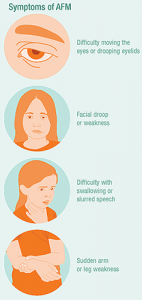
In the coming weeks, it is likely that there will be more reported cases of a rare and mysterious condition called acute flaccid myelitis (AFM), which is causing paralysis in children.
The Centers for Disease Control and Prevention announced this week that it would begin posting on its website new counts of suspected and confirmed AFM cases on Monday afternoons. So far in 2018, the U.S. public health agency said there have been 127 suspected and 62 confirmed AFM cases in 22 states. About 90 percent of the cases have been in children age 18 and younger. In 2014, the agency saw an uptick in AFM cases; so far there have been 386 cases since that year.
Symptoms include sudden weakness or a loss of muscle tone in legs and arms.
Those symptoms seem to echo polio, a contagious virus that attacks the nervous system and can cause paralysis. The condition terrified the public until development of a vaccine in 1955. There have been no polio cases reported in the U.S. since 1979.
The CDC said AFM is not believed to be caused by the poliovirus, but has been unable to pinpoint a direct cause. The agency said AFM-like symptoms could be caused by certain types of viruses, such as enterovirus (which usually occurs in the gastrointestinal tract and can attack the nervous system), or by exposure to environmental toxins. However, the agency said that it hasn’t yet been able to link AFM to a particular toxin, virus or other pathogen.
Such uncertainty is frightening, but Nancy Messonnier, M.D., director of CDC’s National Center for Immunization and Respiratory Diseases, told reporters at an Oct. 16 telebriefing that research points to the condition being rare and treatable if caught early.
For reporters wanting to cover this unfolding story for their community, check out how some news organizations have written about it. Many, such as USA Today, are using a “frequently asked questions” format to help readers assess what they can do to protect their children and themselves. Journalists may want to follow the Twitter account of Messonnier, as well as infectious disease reporters like Stat’s Helen Branswell, the Washington Post’s Lena Sun and NBC’s Maggie Fox.
To learn more about how the CDC investigates mysterious outbreaks in general, read Maryn McKenna’s book, “Beating Back the Devil,” which tells about the CDC’s epidemic intelligence service. EIS agents are detectives that race to stop outbreaks in the U.S. and around the world.
Local public health departments, researchers at local universities and neurologists at local hospitals also are likely to be good sources. The transcript of this week’s CDC press briefing may help generate interview questions.
Resources & recent coverage
- AHCJ: AHCJ’s infectious disease resource page
- CDC: AFM resources webpage
- NIH’s Genetic and Rare Diseases Information Center: AFM resources webpage
- Scientific American: “Poliolike” Childhood Muscle-Weakening Disease Reappears – Oct. 18, 2018
- Big Cities Health Coalition: Report on local infectious disease epidemiologist resources
- Washington Post: Paralyzing Polio-Like Illness Mainly Affecting Children Confirmed in 22 States, CDC Says – Oct. 16, 2018
- Los Angeles Times: What is AFM? Everything You Need to Know About the Polio-Like Virus Suddenly Affecting Children Across the U.S. – Oct. 17, 2018
- MinnPost: Mike Osterholm: A Q & A on AFM, the Rare Polio-Like Illness Diagnosed in 6 Minnesota Children – Oct. 17, 2018









